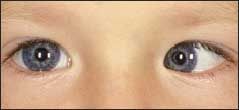Strabismus: What to Tell Parents and When to Consider Surgery
When do a baby's eyes stop deviating? When is surgery indicated for a child with esotropia? Answers here.
I have 2 questions about strabismus:
1. At what age do a baby’s eyes stop deviating? (I currently tell parents that this usually occurs at 3 to 6 months.)
2. When is surgery indicated for children with esotropia? (Many affected children seem to spend endless years wearing glasses and eye patches.)
-- Mark Weinreb, MD
Laconia, NH

Click to Enlarge
Disconjugate gaze can be normal during the first few months of life. Infants are rarely born with their eyes aligned. During the first month of life, the alignment can vary from a small esotropia, to straight, to a small exotropia. Alignment can be more accurately assessed at about 3 to 6 months of age.1
If the child is wearing eyeglasses and a patch, then misalignment (most likely accommodative esotropia) and amblyopia are both being treated. These 2 problems are associated-but are managed in different ways.
Alignment. Accommodative esotropia is treated initially with glasses. The glasses may not improve visual acuity. They are used so the child does not have to make the accommodative effort; the eyes may not “turn in” and the child can use the eyes together, binocularly. If the eyes are aligned with spectacle correction, surgery may never be required. However, if the eyes are not aligned with glasses and/or bifocals, or if the child cannot be weaned from bifocals as he or she grows, then surgery may be indicated. We all lose our ability to accommodate for near tasks as time goes by-the loss of accommodative effort over time is of benefit to children with accommodative esotropia, because they may outgrow the need for glasses and avoid muscle surgery
Amblyopia. Amblyopia is treated by penalizing the stronger eye. Children need treatment (either a patch or atropine eye drops) until vision is equal in both eyes. Surgery does not improve vision. Because vision may regress when patching is discontinued, we often do parttime patching for years. Once children have outgrown the amblyopic age group (between 7 and 10 years old), then the visual system is mature and further patching will not help. By the same token, children are no longer at risk for losing vision when patching is discontinued.
One analogy is that the visual system is like cement. Initially, it is very liquid, and patching can change the vision within days. As the cement becomes more solid (as the child ages), vision can still be improved, but it takes longer to achieve the desired result. Also, visual improvements are less likely to regress in older children. At some point, the cement hardens and vision can no longer be improved. Unfortunately, we do not know exactly when this “hardening” takes place, but it occurs at an older age than was once believed. We try to ensure that vision is at its maximum by the time the visual system matures, and therefore we continue to follow these children until they are about 8 to 10 years old.
-- Linda S. Nield, MD
Associate Professor of Pediatrics
West Virginia University School of Medicine Morgantown
-- Linn M. Mangano, MD
Assistant Professor of Ophthalmology
Department of Pediatric Ophthalmology
West Virginia University School of Medicine Morgantown
References:
REFERENCE:1. Sondhi N, Archer SM, Helveston EM. Development of normal ocular alignment. J Pediatr Ophthalmol Strabismus. 1988;25:210-211.
FOR MORE INFORMATION:
•Nield LS, Mangano LM, Kamat DM. Strabismus: a close-up look. Consultant For Pediatricians. 2008;7:17-25.